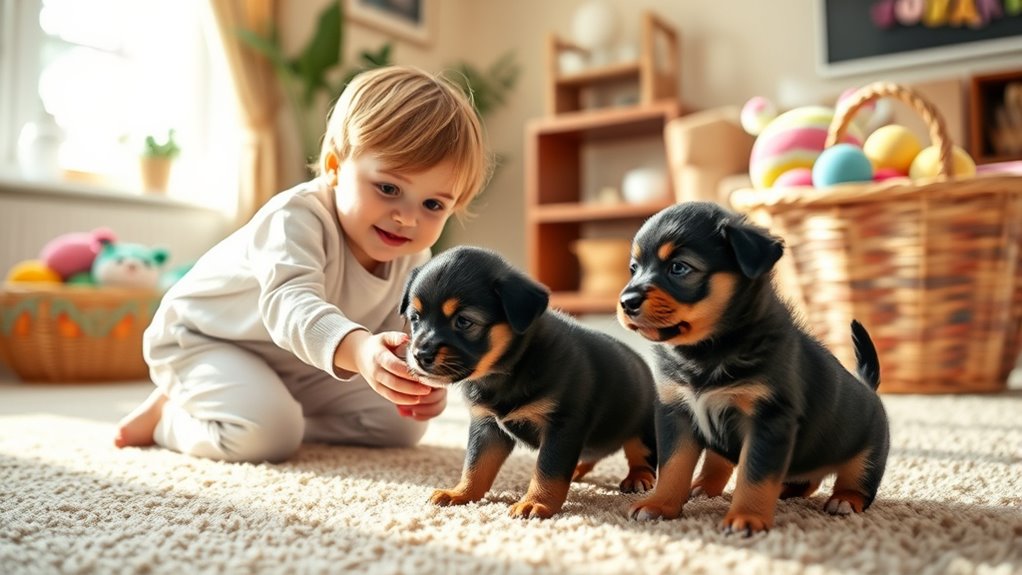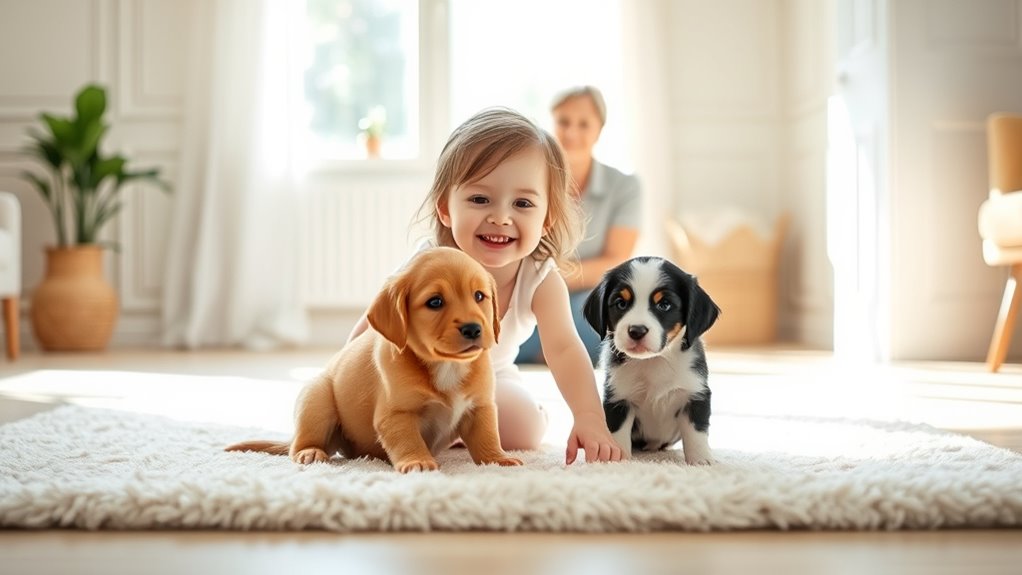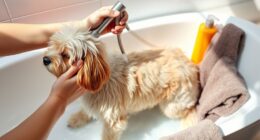When introducing a puppy to your children, make sure the environment is calm and neutral to promote positive interactions. Teach your children to be gentle, use soft voices, and ask permission before petting. Supervise all first meetings to prevent rough handling and accidents. Incorporate short, reward-based training into your routine, involving your kids to foster responsibility and bond. Starting with these steps sets a safe foundation—continue to discover how you can build a trusting relationship.
Key Takeaways
- Choose a quiet, neutral space for initial puppy-child interactions to minimize stress and distractions.
- Supervise all interactions to prevent rough handling and ensure safety for both puppy and child.
- Teach children gentle handling, asking permission before petting, and recognizing puppy stress signals.
- Incorporate short, positive training sessions involving children to promote responsible bonding and good manners.
- Educate children about puppy behaviors and set clear boundaries to foster respectful, safe interactions.

Introducing a puppy to children requires careful planning to guarantee a positive and safe experience for everyone involved. When you’re bringing a new puppy into a household with kids, it’s essential to prioritize puppy training and child safety from the start. Proper puppy training not only teaches your puppy good manners but also helps children learn how to interact safely and respectfully. Establishing boundaries early on ensures the puppy understands what’s acceptable and what isn’t, reducing the likelihood of accidents or misunderstandings. Simultaneously, promoting child safety involves educating your children on how to approach and handle the puppy gently. Children should learn to avoid pulling on ears or tails, and to recognize puppy signs of discomfort or stress, such as growling or backing away.
Before introducing the puppy, prepare your children by explaining what to expect and emphasizing the importance of being gentle and calm. Remind them that puppies are small and fragile and that their behavior can be unpredictable as they adjust to their new environment. Encourage your kids to use soft voices and gentle touches, and teach them that they should always ask for permission before petting or handling the puppy. This sets the tone for respectful interaction and helps build a bond based on trust. To make the introduction smoother, choose a quiet, neutral space where the puppy and children can meet without distractions or overwhelming stimuli. Keep initial interactions supervised at all times to intervene if needed and prevent rough play or accidental injuries.
Incorporate puppy training into your daily routine right from the beginning. Short, consistent training sessions teach your puppy commands like “sit,” “stay,” and “gentle,” which are crucial for maintaining control and safety. When children are involved in training, it’s a fantastic way to foster their responsibility and strengthen their bond with the puppy. Make sure that training sessions are positive and reward-based, so your puppy associates good behavior with praise and treats. Remember, patience is key; puppies are learning how to navigate their new world, and children are still developing their understanding of safe handling. Using appropriate training tools can also help reinforce good behavior and improve communication between the puppy and your children.
Frequently Asked Questions
How Can I Tell if My Child Is Ready to Meet a Puppy?
You can tell your child is ready to meet a puppy by evaluating their child readiness and age considerations. Typically, children over five tend to handle interactions better and understand gentle behavior. Observe if your child can follow instructions, shows patience, and is gentle around animals. If they’re curious, respectful, and can maintain calmness, it’s a good sign they’re ready for a positive puppy introduction.
What Are Signs of a Puppy Feeling Overwhelmed Around Children?
You might notice a puppy feeling overwhelmed if it shows signs of stress, like licking its lips, yawning, or avoiding eye contact. Flattened ears, tucked tail, or attempts to retreat are clear puppy body language signals it’s uncomfortable. These signs indicate the puppy needs space and a calm environment. Recognizing these cues helps you intervene early, ensuring both your child and puppy have a positive, stress-free interaction.
How Do I Handle Allergies When Introducing Puppies to Kids?
You should start by allergy testing your children before introducing a puppy. If allergies are a concern, consider hypoallergenic breeds known to produce fewer allergens. Keep the puppy clean with regular baths and grooming, and create allergy-free zones in your home, like bedrooms. Use HEPA filters to reduce airborne allergens, and always monitor your child’s reactions. These steps help guarantee a safe, enjoyable introduction while minimizing allergy issues.
What Activities Promote Positive Interactions Between Children and Puppies?
You can promote positive interactions by encouraging your child to play gently with the puppy using soft, safe dog toys. Teach them to approach calmly and handle the puppy with gentle petting, avoiding rough play. Supervise all activities closely to make sure both stay comfortable and happy. This helps build trust, fosters a bond, and creates a safe environment where your child and puppy enjoy each other’s company.
How Long Should Initial Supervised Interactions Last?
You should limit initial supervised interactions to about 10-15 minutes, following duration guidelines to prevent overstimulation. Keep a close eye on both the puppy and child, watching for signs of discomfort or agitation. Use supervision tips like gentle guidance and calm voices to guarantee positive experiences. Gradually increase the time as they become more comfortable with each other, always prioritizing safety and calmness during these early interactions.
Conclusion
Remember, introducing a puppy to your children is like planting a seed for a lifelong bond. Be patient, gentle, and attentive, letting trust blossom naturally. Keep supervision constant and respect everyone’s boundaries. With time and care, your puppy and kids will grow together, forming a relationship as strong as an oak tree’s roots. When you nurture this connection carefully, you’re laying the foundation for a joyful, safe companionship that will flourish for years to come.










